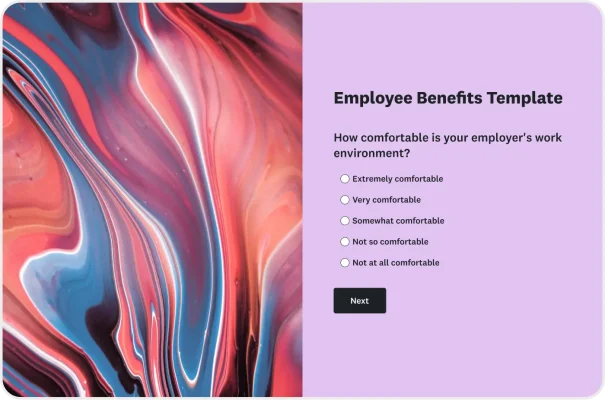Employee Benefits Survey Template
Used 1,000+ times
Use this Employee Benefits Survey Template to identify how to improve your employee benefits program.
Are your employee benefits best-in-class or just covering the bare minimum? The answer could have a huge impact on employee satisfaction, retention, and the long-term success of your business.
Employee benefits surveys are the best way to uncover your team’s needs and preferences, so you can tailor your benefits program accordingly. Because you can’t improve your benefits package until you know exactly what needs improving.
What are the strengths and weaknesses of your company benefits? Which offerings are the most valuable to employees and have the biggest influence on engagement? Our research shows that over half (53%) of employees believe companies should focus on their well-being. Do your employees feel the same—and are your benefits falling short?
A generous salary is great, but it can’t overcome all; your benefits should be competitive and thoughtfully designed. To get there, you need to prioritize employee benefits data within your overall employee feedback program. With the right feedback, you can discover opportunities to better support employees and spot benefit satisfaction red flags before they become an issue.
What are employee benefits surveys?

An employee benefits survey asks employees for their opinions about your company’s benefits program. This data helps HR professionals:
- Understand what team members think about current offerings
- Uncover what isn’t meeting expectations
- Identify what changes or additional perks employees want to see
- Improve the overall employee experience
Employee benefit surveys also reveal how different employees value different benefits. For example, retirement benefits, health coverage, and fertility planning benefits may be viewed differently across generations, genders, or single versus married employees. In our research, we found that Gen Z employees want their company to prioritize work flexibility nearly two times more than Boomers.
Getting clear data and feedback on current and potential benefits will help you offer a balanced package that’s more likely to hit the mark with employees.
How do employee benefits surveys help your business?
Over a third (35%) of workers say their company leadership doesn’t understand employee needs. This kind of oversight is bad for business and your benefits offerings.
By consistently conducting employee benefits surveys, you not only show employees that their feedback shapes company policies, you also get the data you need to make better decisions for your team and your business.
Here are some of the ways employee benefits feedback can impact your business:
Retention and engagement
Company benefits that don’t meet employees’ needs are a huge risk to your retention; employees are more likely to start looking for a new role at another company offering what you’re missing. Even if they do stick around, your employee engagement will likely take a hit. It’s harder for a team to feel motivated to do their best work if they’re not supported in the right ways. With feedback, you can see what matters to employees and craft strategies to get on course.
Tailored benefits for diverse needs
Today’s workforce is the most diverse ever in terms of age, gender identity, ethnicity, educational experience, and work experience. So, it’s especially important for HR professionals to keep up with the needs of each and every employee. As we mentioned above, employee benefits surveys make it easy to slice and dice data and make sure that no voice—or benefits opinion—gets lost in the shuffle. They help you understand the nuances of preferences, rather than taking a misguided one-size-fits-all approach.
Cost savings
Spending money on benefits that aren’t needed or valued is a waste of precious resources. Employee benefits surveys crystallize what’s a necessary expense, where you need to pull back, and what new investments you should explore. That way, you can be sure that you’re paying for benefits that actually resonate with your team.
Improved employee satisfaction
Your company benefits can play a big role in how content employees are with their jobs and work environment, a.k.a employee satisfaction. This has a far-reaching impact on everything from your employee Net Promoter Score (eNPS®) and employee performance to customer satisfaction—because satisfied employees provide better customer service. When you understand what matters most to employees, and show that you’re listening, it does wonders for employee wellbeing and happiness.
20+ examples of employee benefits survey questions
The questions that you ask in your employee benefits surveys will depend on your needs, but it’s usually helpful to get a baseline of employee opinions with questions like:
- How satisfied are you with your employee benefits?
- Rate your agreement to the following statement: I have a generous benefits package relative to my local market.
- MaxDiff question: From the following list of benefits, please select the one that is most important to you, and then choose the one that is least important to you.
Employee benefits survey questions tend to cover common types of benefits, and there may be times when you want to home in on certain areas like employee compensation and financial benefits, health insurance, work-life balance, and more.
For instance, let’s say that you’ve been receiving negative exit survey feedback about your company’s work-life balance. In your next employee benefits survey, you should make sure that you’re asking questions that dig into that aspect of your offerings so you can get a fuller picture of employee sentiment.
Here are some common topics that employee benefits surveys cover, with example questions:
Health insurance benefits
- Is your employer’s health insurance plan better or worse than those of other employers?
- Rate your agreement to the following statement: It is easy to choose a health insurance plan.
- Rate your agreement to the following statement: My healthcare insurance meets my family’s current needs.
Retirement benefits
- Rate your agreement to the following statement: My employer’s contribution to my retirement fund is more generous than other employers.
- How confident are you that you are on the right track to save enough for retirement?
Stock options
- Rate your agreement to the following statement: I value being offered equity in my company.
- Rate your agreement to the following statement: I understand my company stock options.
Paid time off
- How fair is your employer’s sick day policy?
- How satisfied are you with your company’s paid time off policy?
- How comfortable do you feel requesting time off?
Parental leave
- Rate your agreement to the following statement: My employer offers a generous parental leave package.
- Rate your agreement to the following statement: If I have questions about my employer’s parental leave policies, I know where to go to find answers.
Work-life balance and wellness
- How satisfied are you with your employer’s expectations regarding work hours?
- How easy is it to adjust your work schedule to accommodate personal commitments?
- How satisfied are you with your employer’s mental health benefits?
Flexible work benefits
- How comfortable is your employer’s work environment?
- How satisfied are you with your employer’s flexible work/remote work policies?
- How often would you prefer working remotely?
Professional development
- How satisfied are you with your employer’s professional development opportunities?
- What type of professional development activities would you find the most helpful?
- Rate your agreement to the following statement: I feel supported to pursue professional development.
Food benefits and catered meals
- How satisfied are you with the snacks available in the office?
- Rate your agreement to the following statement: My employer’s catered meals offer enough dietary options.
These are just a sample of common employee benefits categories. Not sure what else to ask in your surveys? Just think about your current benefits offerings and your unique culture and organization. If the majority of your employees are recent graduates, you could investigate the value of benefits that help with student loans or continuing education. If your organization recently rolled out a new hybrid work model, you could include questions to determine employees’ satisfaction with it.
The beauty of using this SurveyMonkey employee benefits survey template is that you start with a great foundation of questions and can easily fine-tune to collect even more feedback.
Employee benefits survey best practices (3 tips for success)
Want some rapid-fire employee benefits survey guidance? Here are three tips to keep in mind as you plan out how and when to ask for feedback on your company benefits.
1. Anonymous employee benefits surveys
Anonymous employee surveys spark more candid feedback. To uncover what people really think about your company's benefits, give them the chance to share their thoughts anonymously—and let them know that their answers won’t be identifiable.
2. Consistent employee benefits surveys
Aim to send your employee benefits survey at least once a year. This will help you maintain fresh data and set annual benchmarks for employee benefits satisfaction. For more timely insights, or to track trends more closely, you could send your survey bi-annually.
3. Open-ended employee benefits survey questions
In addition to quantitative employee benefits questions, consider including at least one open-ended question to hear from employees in their own words. This could be as simple as asking employees if there’s anything else they want to share about their benefits preferences. The answers you receive may surprise you—and lead to new ideas for how to update your benefits program in the future.
Collect feedback with our Employee Benefits Survey Template
Improve your benefits program by collecting and acting upon employee feedback. Get started today with SurveyMonkey.
Looking for more resources? Explore more SurveyMonkey employee benefits survey templates and solutions for HR professionals.
Explore related templates
Explore which features support this survey template
We have so many powerful features to help you launch surveys quickly, but here are our most popular ones for new users.
Customizable survey experiences
Out-of-the-box themes, accessible color palettes, custom fonts, branding, and more.
Many ways to send your surveys
Collect survey responses via email, website, SMS, social media, QR codes, offline, and more.
Survey analysis, no training required
Automatic results summaries, filters, custom dashboards, crosstab reports, text analysis, & more.
Additional resources to help you launch successful survey projects

Success Stories
Read about our customers, explore webinars, and get guides on collecting feedback in your industry.

Blog
Get tips on how to create better surveys, hear the latest product news, or check out our research.

Help Center
Access tutorials on how features work, learn more about billing, and contact Customer Support.




